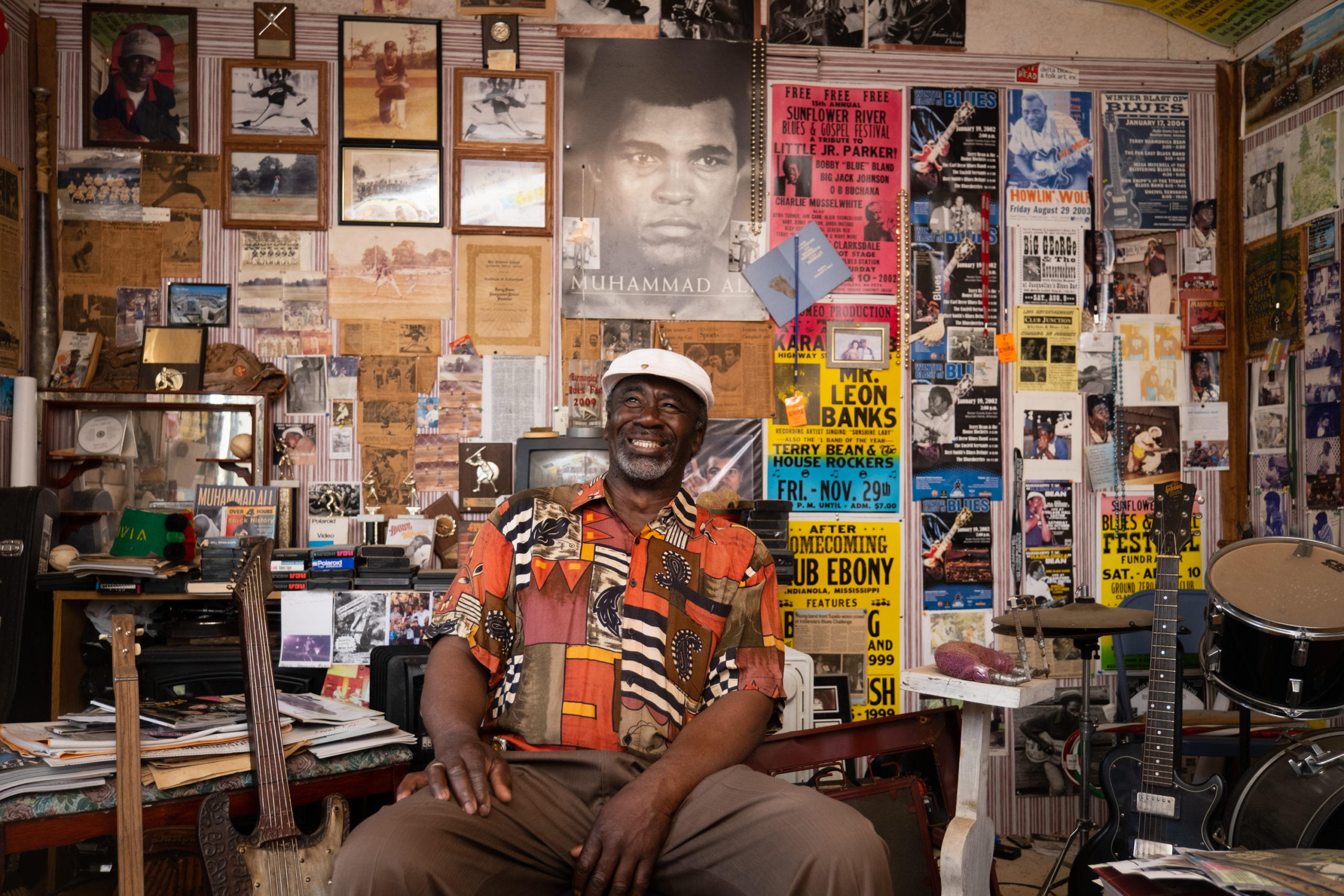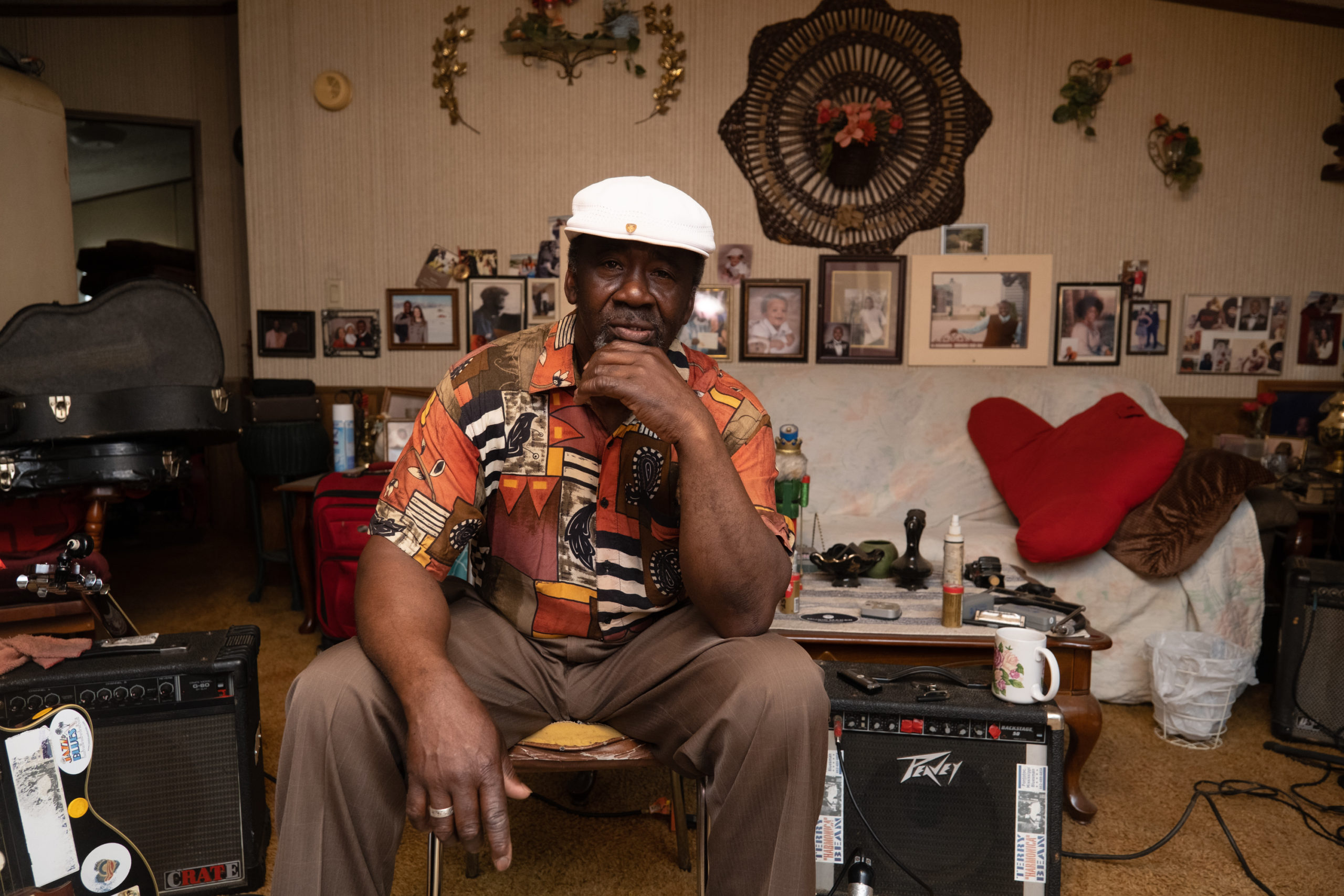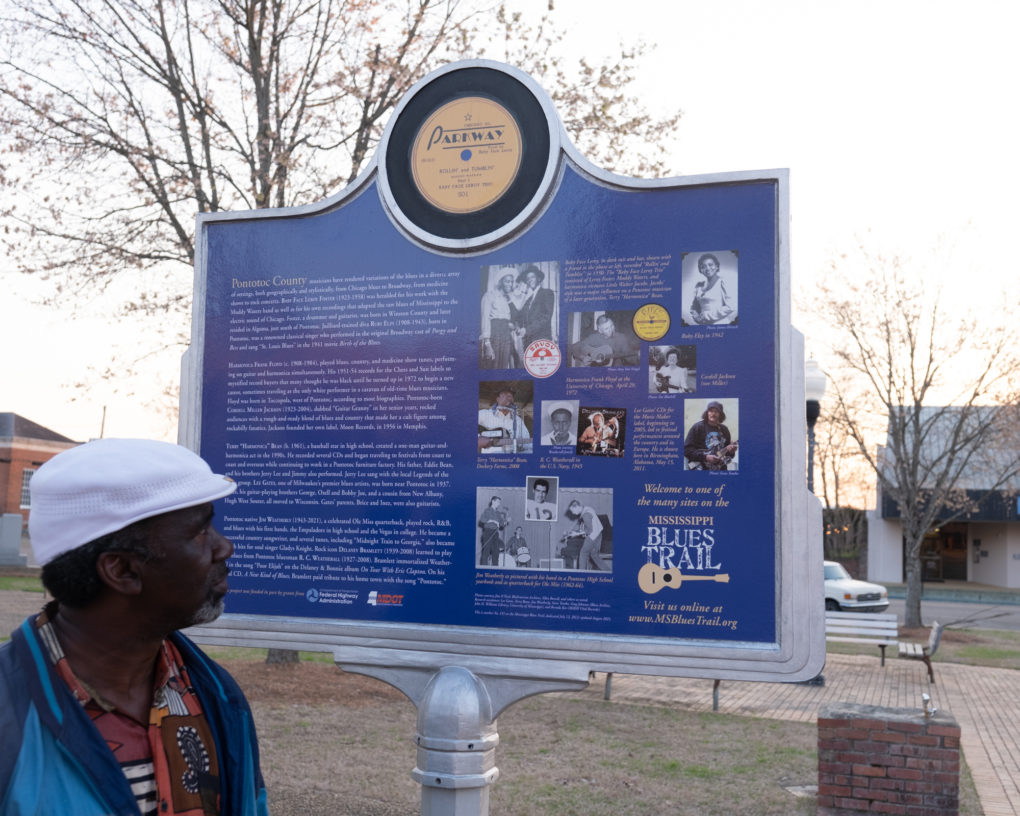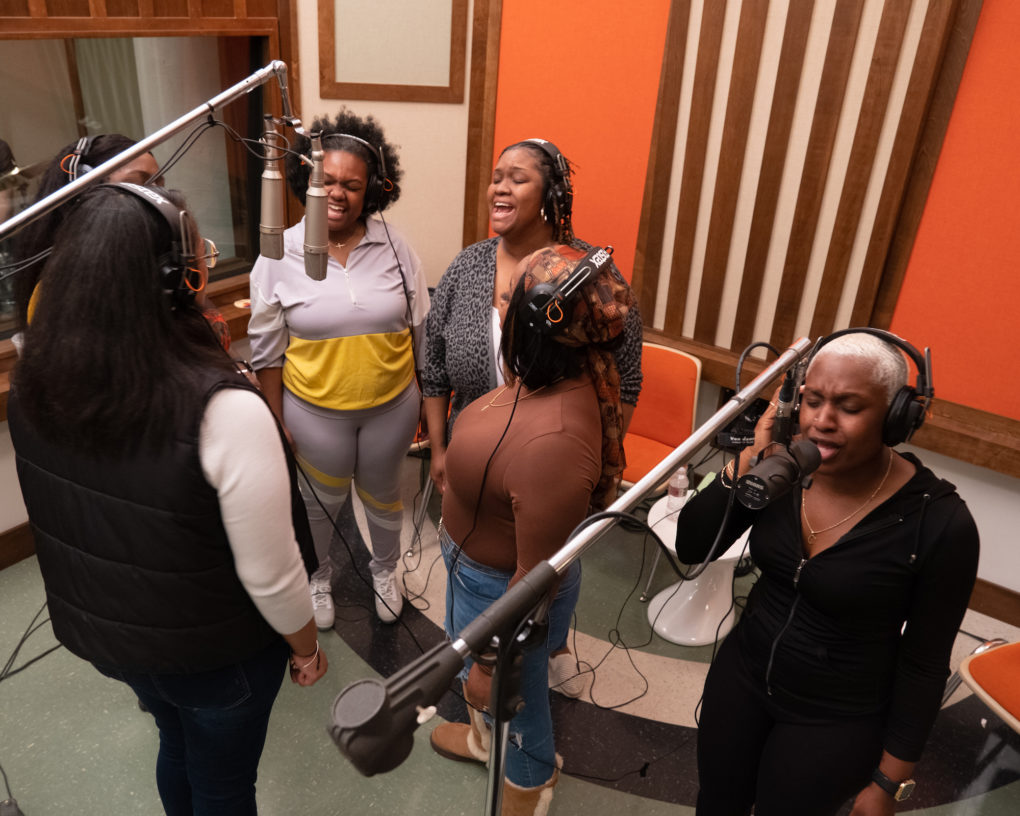Mississippi to Memphis: Tales From the Road
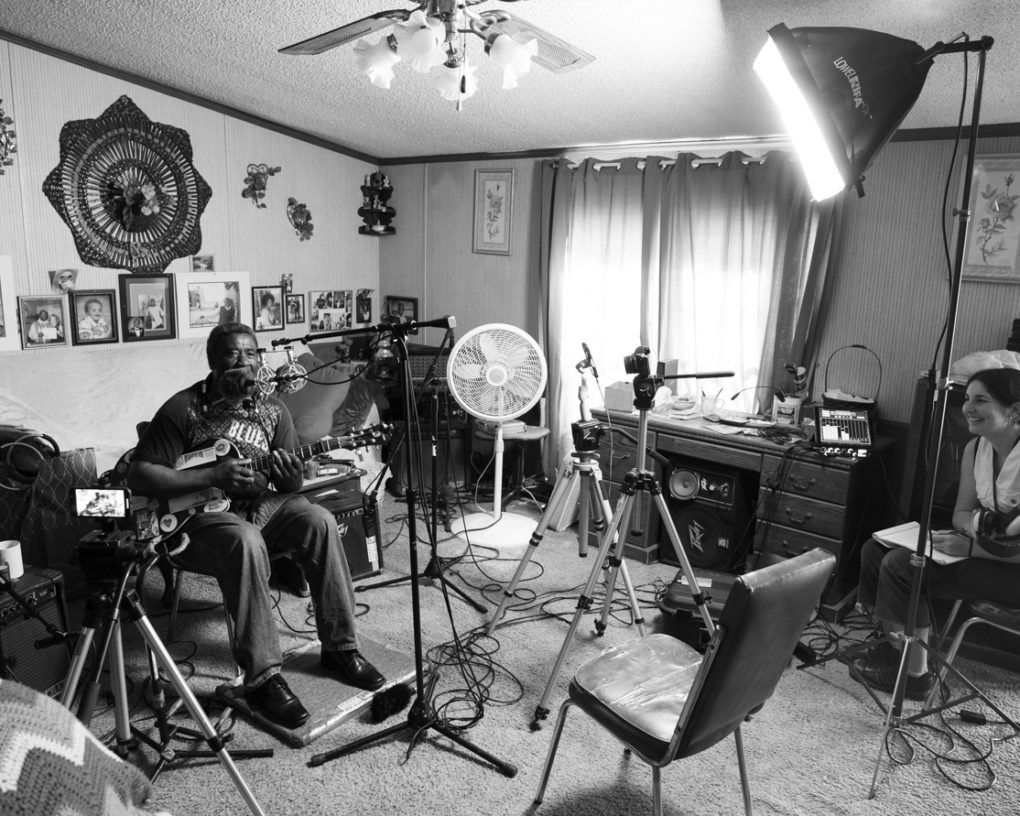
In early March, Music Maker Executive Director Tim Duffy, Communications Coordinator Tess Stogner, and Program Manager Gabi Mendick (me!) went on a musical road trip. As always at Music Maker, an adventure was had. Read on to hear about what we got up to on our Mississippi and Tennessee travels.
Monday
After a few hours of driving southwest from North Carolina, the sun rises and we break out the tunes. We listen to Music Maker’s unreleased recordings of David Bryant, son of Cora Mae Bryant and grandson of Curley Weaver. Blues runs in David’s blood, and you can clearly hear the musical influence of the generations that came before him in his music. David’s voice is raw and heartwarming, his guitar playing eccentric and entirely his own.
We make it all the way to Birmingham in good time and treat ourselves to barbecue at the legendary Saws. I go for a chicken sandwich smothered in the local favorite, white sauce. I want to like white sauce, but I’m sorry to say I’m not so sure I do. (Don’t @ me, but please do share your favorite Birmingham barbecue joint in the comments.)
From Birmingham we drive on towards Pontotoc, Mississippi, where we plan to meet Terry “Harmonica” Bean the following morning.
I met Terry once before, at the Black Belt Folk & Roots Festival in Eutaw, Alabama last year. Terry’s set was captivating, showing off his command of the harmonica. Following the performance, I chatted with Terry who, in the midst of an animated conversation, whipped out his harmonica and treated me to an encore.
After a long day on the road, we rest easy in Tupelo, Mississippi for the night. This is the birthplace of Elvis, and we’re reminded of it at every shop window and street corner. Every insurance company and trendy coffee shop has a mural painted on their brick facade, or at the very least a cardboard cutout of the king.
Tuesday
When we pull up to Terry’s house, he immediately takes us on a tour around his property – we get a glimpse of his various collections of objects big and small, from old trucks to bicycles, to about ten puppies yipping in a pen.
His house is perched on a top of a hill, one that he has built himself (the hill, not the house), all using his own two hands and various discarded materials. Word has gotten around that Terry allows people to dump unwanted items at his house, most of which Terry recycles and puts to a new use. Walking around, I’m reminded of the sheer amount of waste that individuals produce and send to landfills. Terry embodies the saying “one man’s trash is another man’s treasure.”
We are led to a small building behind the house, Terry’s Blues Museum. Floor to ceiling is covered in festival posters, photographs, and all sorts of memorabilia. I could spend a day looking around this room, which is no bigger than a shed. One corner is dedicated to the days of Terry’s budding baseball career. He was meant to be drafted to the major leagues after high school, but an injury derailed his plans, and he found himself pursuing the blues.
We set up in Terry’s living room to record his songs; he treats us to his Hill Country blues, singing, playing guitar, with plenty of harmonica. Between songs, Terry tells stories about his father and grandfather, who were both musicians. He shares his musings on blues music today and his favorites from the past, “The old recordings with the Muddy, Wolf, all of them – that stuff still sounds good today.”
Terry’s songs all start as stories. He tells anecdotes, recalling sitting on the porch with his grandaddy, and the memory leads into song. Terry tells us lessons he picked up being around music from a young age. Back in the day the guitar player and the harmonica player in a band always had trouble and got into fights, because they tended to have the most success with women. It’s the reason Terry plays both guitar and harmonica himself, and at the same time. “That’s the part you don’t hear about in the books,” he laughs.
After a full day of recording, on our way to grab a bite, we stop in the main square in Pontotoc to see a plaque honoring “Pontotoc County Blues,” and Terry “Harmonica” Bean’s contributions. We’re also met with an exciting surprise – a photo of Music Maker partner artist Lee Gates with a nod to Music Maker.
Over carne asada and enchiladas, Terry tells endless stories of touring across the country and traveling to festivals in Europe. We’re done eating before Terry has taken a bite of his steak. We say goodbye after a full day of recording his stories and songs, excited to build a partnership with Terry.
Wednesday
Part 2 of our trip begins. We take backroads from Pontotoc to Memphis, our destination for the next few days. Last spring, our partners at Bible & Tire Recording Co. flew out to North Carolina to hear some of the great gospel music in the region. Bible & Tire Founder Bruce Watson and Project Manager Will McCarley were struck by Faith & Harmony, a group that consists of two sets of three sisters who are first cousins. They decided to bring the family band over to Memphis to record their first full-length album.
We arrive at Crosstown Concourse, which houses Southern Grooves Productions, the recording studio that’s rented out for the session. The world class, state-of-the-art studio was built by producer Matt Ross-Spang and opened in 2021. Matt tells us about Crosstown Concourse, a complex that opened in 1927 as a Sears, Roebuck & Co. distribution center. The distribution center closed in 1993 and the 1.5 million square-foot building sat vacant for twenty years. In recent years, the building was renovated and converted into a mixed-use space, including restaurants, art galleries, and of course, Southern Grooves.
As Matt, Bruce, and Will set up for the session the following day, we get a tour of the studio. I can’t begin to comprehend the gadgets and gear in the space, but I’m impressed, and I sure can appreciate the 70s design; burnt orange runs throughout, the patterned linoleum floor evokes a school cafeteria in the best way, and I’m still dreaming about the Umbo bookshelf.
Thursday
Back at the studio in the morning, the space fills up fast. The Faith & Harmony crew arrives – Kadesha Spaight, Renay Sugg, KeAmber Daniels, Andrea Edwards, Christy Moody, and Tinesha Weaver. The women are accompanied by brother/cousin, keyboard player, and manager of the group Antwan Daniels, as well as parents/aunt and uncle, Anthony and Chiquita Daniels. Antwan and Anthony are also members of The Dedicated Men of Zion, who have released two albums with Bible & Tire. The expansive Vines-Daniels family is overflowing with talent. Faith & Harmony are carrying on traditions passed through their family and instilled in them from childhood; they are the granddaughters of Johnny Ray Daniels and Dorothy Vines, founding members of the Glorifying Vines Sisters. Throughout the session in the upcoming days the women often speak of Johnny Ray, mimicking his dance moves and his singing style.
Everyone settles into the studio. For each song on the docket one woman sings lead, while the other five gather around a microphone to harmonize. They are accompanied by an all-star band; Antwan Daniels on keys, Will Sexton on guitar, Matt Ross-Spang on guitar, Will McCarley on drums, and Mark Stuart on bass.
As Bruce records behind the board and Tim photographs the action, Tess and I shoot video, documenting the process.
Anthony and Chiquita came along for moral support, but the women also look to Anthony for musical advice. When an arrangement needs to be fine-tuned, or something isn’t working out quite right, eyes turn towards the booth where he sits. He chimes in only when needed, demonstrates notes, and then steps back and lets them do their thing. He beams with pride seeing his daughters and nieces singing together.
Throughout the recording session, I simply feel lucky to get to be in the room, to listen and observe. I don’t know how these women’s voices are so powerful. They continue singing take after take, belting for hours. Eating potato chips to oil up their gullets, diluting cough drops in plastic water bottles.
The day concludes with Cree’s solo, “Crying in the Rain.” Bruce previously suggested that the group add this song to their repertoire and I’m so glad he did. It’s a heart-wrencher. When we leave for the day, the power and emotion in Cree’s voice resonates with me.
Friday
Back at it. For day two of recording, everyone knows the drill and gets straight into the groove. It’s extremely heartwarming to see how these women interact. They joke around, but they’re the most supportive and encouraging group I have ever seen – family or band, and family bands included.
Toward the end of the session, when asked what she learned from the experience, Renay shares, “Sometimes your best, what you may feel like is your best, is not the best that you can do. I learned that from our producer, Bruce. It tickles me; he’ll say, ‘That was really really good guys, but let’s get one more.’ I’m like, ‘Bruce, I really just gave it all I had right there.’ And he says, ‘But you can do a little bit better than that.’ And you did a little bit better than that the second time around.”
The recording session wraps up and the women head back to their hotels to prepare for a photo session later in the evening. Photographer Bill Reynolds is in town from Nashville to get all of the photo assets for the album release later this year, including album art and press photos.
Everyone involved in the recording process brings something vital to the table, all of the individuals work together in harmony (pun intended), bringing out the best in each other.
Saturday
On Saturday, we rise before the rooster crows and start making our way home. The excitement of the week delayed my exhaustion, but on the highway, it begins to set in.
Bruce sends us the rough mixes from the session, which lifts my energy. The songs are still stuck in my head from the day before; they’re so catchy, and I’m eager to listen back. The tracks don’t sound “rough” to me, these life-long singers and musicians are pros and recorded ten hit songs in two days. Music has always been a touchstone for Faith & Harmony, they still sing songs today that were ingrained in them from childhood. Between the six women, they have several children who are already musical, following in their mothers’ footsteps. As far as talent is concerned, this is the family that just keeps on giving. I can’t wait to hear what’s next.
By Gabi Mendick.
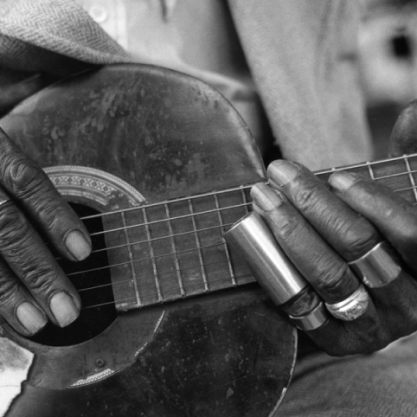
Get involved
& give back
The Music Maker Foundation is a 501(c)(3) nonprofit organization that depends on thousands of supporters. Together, we work to meet the day-to-day needs of the artists who create traditional American music, ensure their voices are heard, and give all people access to our nation’s hidden musical treasures. Please contribute or shop our store today.
